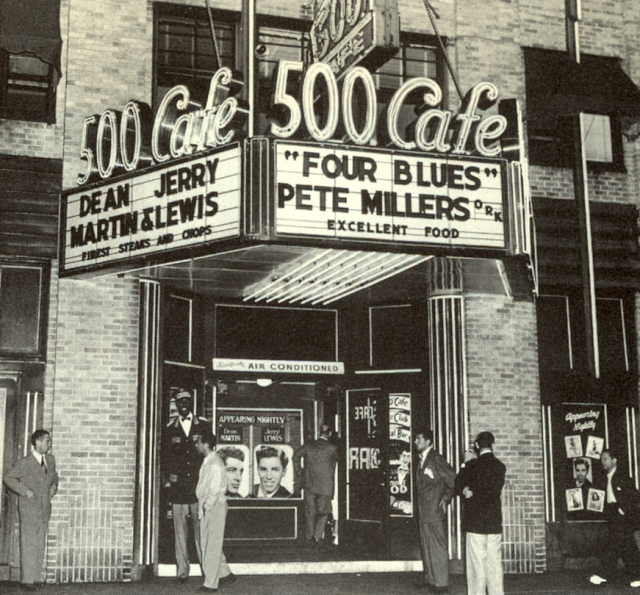The Midway: Seeking "Authentic" Vice

The 500 Club (then the 500 Cafe) featuring Dean Martin and Jerry Lewis, 1946

Club Harlem headlines Larry Steele's Smart Affairs alongside other African American musicians and entertainers, ca. 1950
While the Boardwalk offered a socially prudent world of seemingly respectable entertainments set within a utopian environment, before the 1978 arrival of the city's first legal casino, tourists seeking temporary escape from well-mannered entertainments could indulge their desires for unmonitored revelry in what historian Bryant Simon refers to as Atlantic City's "Midway." Occupying the blocks behind the Boardwalk's glittering shops and hotels, the Midway's promiscuous nightclubs, illegal gambling halls, explicit gay bars, and bawdy jazz clubs, recalling John F. Sears’s concept of “buying sensation,”[1] enabled visitors to abandon the moral and social constructs of their daily lives and assume daring new personas.
With dozens of clubs, bars, and restaurants, the Midway was a world unto itself, which reflected the extent to which “racial primitivism, including the notion of the ‘noble savage,’ pervaded the cultural beliefs of middle-class whites.”[2] Perhaps the two most famous (and best documented) Midway establishments were the 500 Club and the Club Harlem, both of which garnered seductive reputations for "'soft primitivism,' 'managed eroticism' and stylized danger”[3] that spread throughout the Eastern Seaboard well into the 1970s.
Located at the corner of Atlantic and South Missouri Avenues, the 500 Club offered mostly white audiences a lavish brush with fame, fortune, and danger in a swanky modern setting. "The Five" not only hosted the most famous entertainers of the era - Liberace, Dean Martin and Jerry Lewis, Patti Page, Donald O'Connor, Frank Sinatra, and, less frequently, African American performers including Nat King Cole and Sammy Davis, Jr. - but also featured one of the city's largest illegal casinos hidden behind a secret door. Located nearest to the Boardwalk, the 500 Club's offered ordinary white guests the chance to rub shoulders mobsters and celebrities, to pretend to live above the law and transcend quotidian life.
However, the Midway also contained a neighborhood referred to as "the Northside," Atlantic City's bustling distinctly African American enclave. A veritable city within a city, by the early twentieth century the Northside was not only a thriving African American community but also an indelible feature of Atlantic City's entertainment landscape. Prompted by and in spite of the imposition of Jim Crow laws and confining segregation policies, the Northside quickly developed into a vibrant self-sustaining community that catered to African Americans, offering all the goods and services necessary for daily life.
Yet, each night, the Northside took on a much different character as moral and racial barriers became semi-permeable, transforming the neighborhood into an “interzone… where whites and blacks could meet for social and sexual intercourse.”[4] Although they most certainly occurred, it is difficult to assess to the impact and extent to which the Midway achieved productive and progressive racial interactions. In contrast to the Boardwalk's relatively tame and segregated titillations, the perceived ghetto in fact contributed greatly to the resort town's allure, drawing white tourists to the supposedly dangerous side of Atlantic Avenue.
Situated on Kentucky Avenue in the Northside, Club Harlem, Atlantic City's equivalent of New York's renowned Cotton Club, presented racially mixed audiences with elaborate floorshows ranging from one-man comedy acts to scantily-clad burlesque dancers to the country's most famous entertainers. Featuring almost exclusively African American performers, prominent headliners included producer Larry Steele's provocative Smart Affairs, Sepia Revue, and Beige Beauties performed by the "fabulous Club Harlem girls," Cab Calloway, Redd Foxx, Billy Daniels, Ella Fitzgerald, James Brown, Gladys Knight and the Pips, Jackie Wilson, Aretha Franklin, and Sam Cooke. In the summer months, weekend performances began each Saturday and ran until Monday morning thanks to the "Breakfast Shows," which began at six o'clock in the morning.
[1] John F. Sears, “‘Doing’ Niagara Falls in the Nineteenth Century,” in Sacred Places: American Tourist Attractions in the Nineteenth Century, (New York: Oxford University Press, 1989), 19.
[2] Knight, “A Climate for Health and Wealth,” 49.
[3] Simon, Boardwalk of Dreams, 47.
[4] James Gilbert, “Mrs. Wilkins Dances,” in Whose Fair? Experience, Memory, and the History of the Great St. Louis Exposition, (Chicago: The University of Chicago Press, 2009), 151.